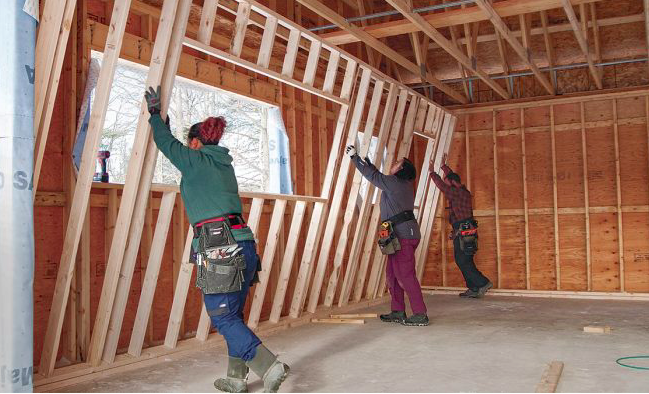
One of the many great things to come out of my work with Dan Kolbert in Portland, Maine, is our mutual desire to monitor the hygrothermal performance of what we are building. After some lengthy research, we settled on burying Omnisense monitors in our assemblies to collect data. It’s a practice I’ve written about here before and have discussed on this BS* + Beer Show episode.
We have a few years’ worth of data under our belts at this point, so I want to throw some of it out there for discussion. What follows is a surface-level look at what’s happening inside some of the double-stud walls Dan and I built together in Maine.
Many of you may be aware of what Dan refers to as “the yeti of building science.” I can’t recall if he coined that phrase but it’s a good one. This “yeti” is the idea that double-stud walls are going to have dangerous levels of moisture accumulation throughout the winter months that will result in anything from mold growth to catastrophic rot and failure. The joke here is that it’s a yeti because it’s often talked about but rarely, if ever, seen.
So, let’s dive into it.
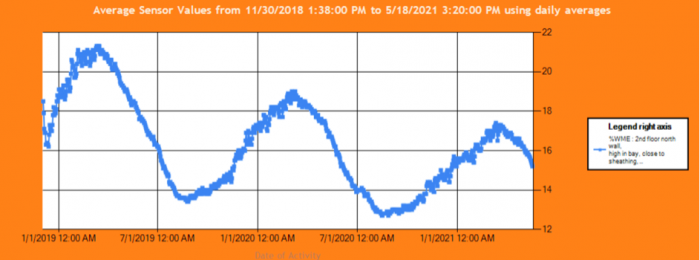
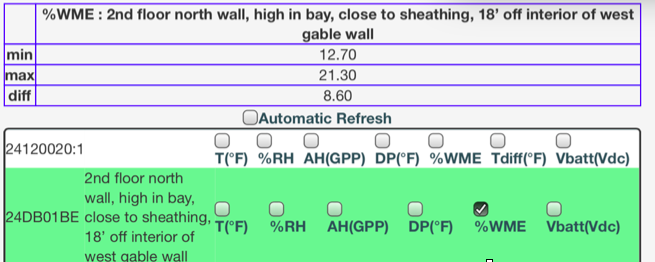
The data in the graph above represent three years—the spring shoulder seasons—inside a double-stud wall. This is a 12-in.-thick cellulose wall on a well-shaded north side. It has a vented rainscreen and corrugated metal cladding. The house tested .61 ACH50 and is served by a somewhat underperforming Panasonic ERV (but that’s another story).
The graph shows wood moisture equivalency (WME) measured in the stud adjacent to the sheathing surface. As one would expect, the wall begins its life with a higher peak, which accounts for the moisture contained in…
Weekly Newsletter
Get building science and energy efficiency advice, plus special offers, in your inbox.

This article is only available to GBA Prime Members
Sign up for a free trial and get instant access to this article as well as GBA’s complete library of premium articles and construction details.
Start Free TrialAlready a member? Log in





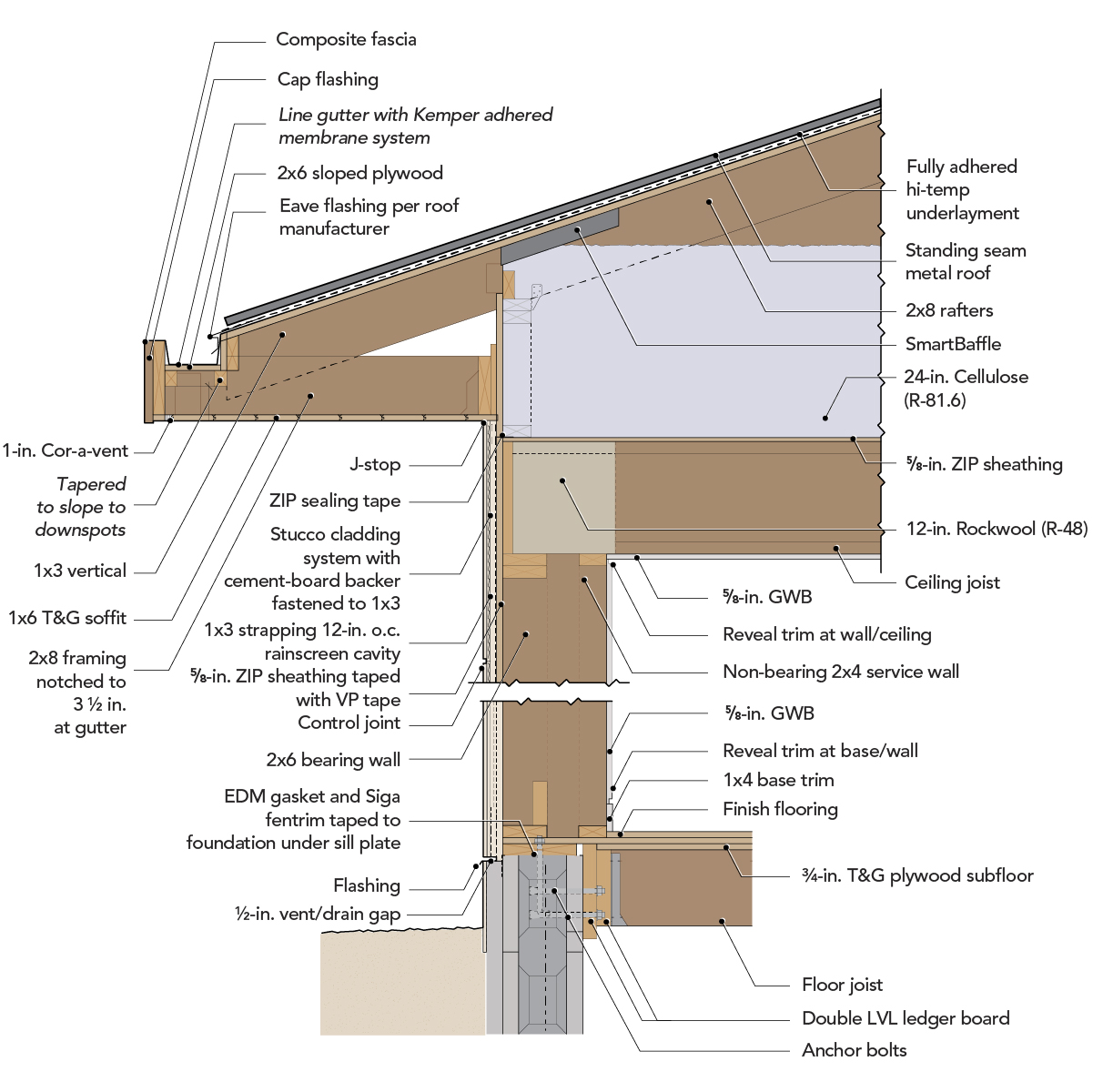
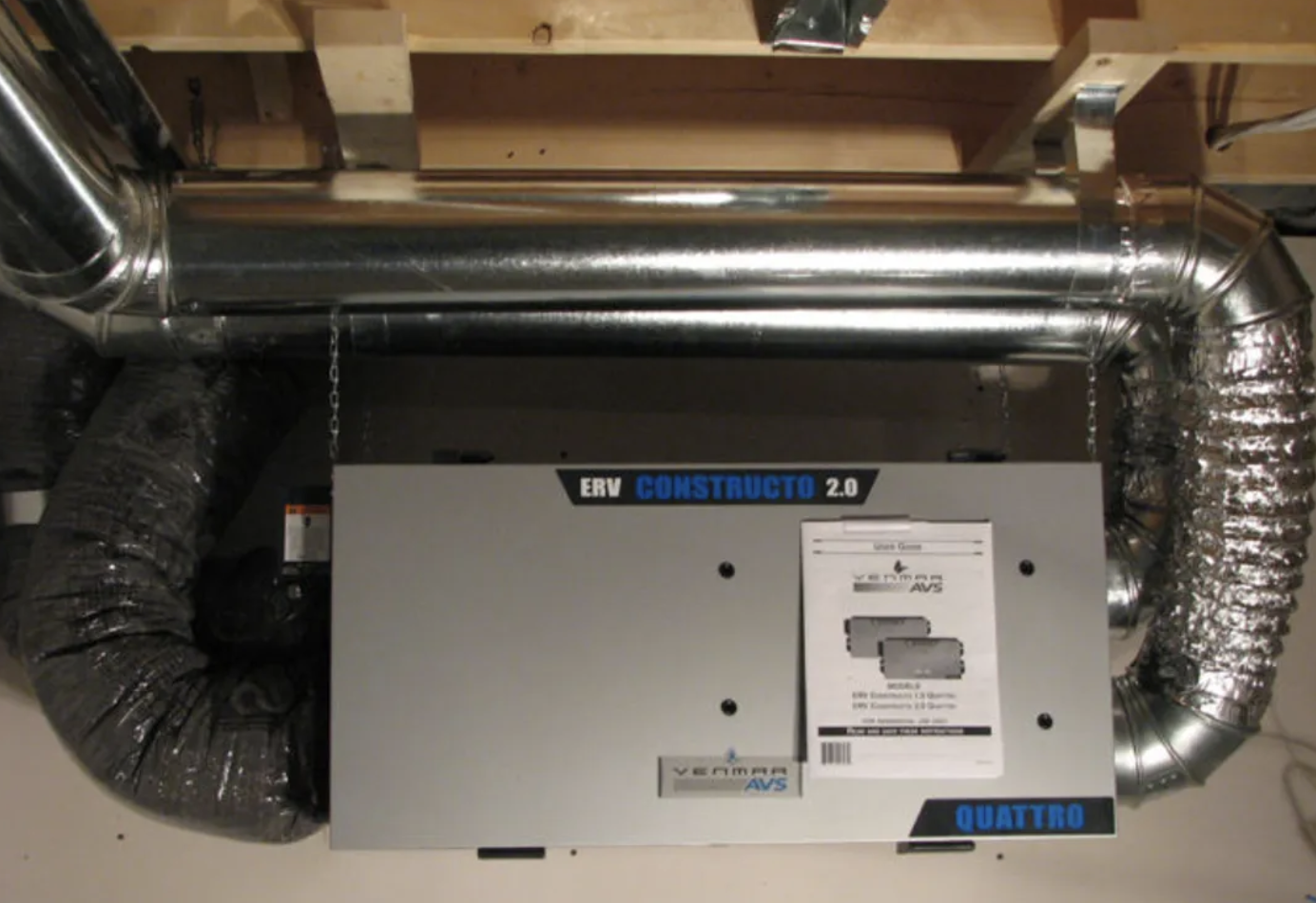








24 Comments
How was the double stud wall built?
I believe this is how the wall was built--it is a common approach that Dan uses. And here is a link explaining it in detail: A Case for Double-Stud Walls.
Thanks Kiley
This particular wall was built very similar to the article Kiley linked to but using 1/2” zip system as the sheathing.
This is awesome data and I wish we had more of it for real houses in real climates. I'd love to have this sort of data for inland locations where the low temperatures get down to -20F or lower.
I see that the minimum temperature at the sensor was 15F. Do you have local weather data for the minimum outdoor temperature? I know that coastal Maine is pretty moderate from the water influence, but 15F still seems high for a low temp. It would be nice to know the difference between wall temp just inside the sheathing and outdoor temp.
You make a great point that I've observed with damp-in-winter walls - the maximum WME corresponds to the minimum temperatures where mold growth slows or stops. I've seen lots of walls that approach or exceed 30% WME in the winter but have no noticeable damage after years of this behavior. Not that I'd be comfortable designing a wall for this behavior, but it happens. The walls you measured would be at little or no risk of moisture damage. Nice work.
I’d love to see more of this data from all sorts of places and assemblies. I have a pet dream of finding some grant money to be able to send more of these sensors out into the masses so we can utilize citizen scientists.
I have an exterior sensor on this project and will overlay some of that data in a future post. I’ll likely approach this framework of a story from a few different angles. So if you have any comparisons you’d like to see I’m happy to oblige if I can.
I am studying to build a thicker walled framed house in Southern New Mexico next year. I wouldn't mind buying sensors and collecting data as part of a broader project.
I’ll be putting a sensor in a 10" double stud wall in SC. Planning to use ZIP and drywall/latex as the vapor barriers.
"The Building Sensor Project." Let's find a way to make it happen!
Count me in! I was already planning to stick a couple sensors in the walls and roof as my remodel progresses, happy to share data!
I wonder if chris from Omnisense would be willing to put something out to his clients. He hosts everyone’s data.
Just out of curiosity, can you give an indication of costs for the sensors and monitoring equipment on this project?
How much are these sensors typically, and where to get them...? Any and all recommendations welcome.
https://www.omnisense.com
You'd need sensors, a gateway, and there's a monthly hosting charge.
Good stuff.
Am I understanding correctly that WME is essentially a conversion to wood %MC from an RH sensor measurement? I.e. it's not a direct wood MC measurement. Not suggesting that's a problem, just clarifying (I expect the actual wood MC would simply be time shifted a bit).
What would be interesting (and a lot of work) is to have data for a variety of assemblies/climates to see which variables change the situation significantly. Conditions variables such as: exterior and interior temps and RH, solar exposure, wind exposure, etc. Assembly variables such as: Insulation types, wall thickness, vapor retarder type and location, sheathing type, interior and exterior finishes, rainscreen, etc.
That would then make it easy to say things like, 'no, a double stud wall isn't prone to failure, unless you do/don't do this specific thing.'
On the other hand, if we have assemblies that we know works, we can just stick to those. Problem is when people don't understand what makes an assembly work and something get's substituted.
my understanding is that WME is the moisture content derived by the equivalency of an electrical charge passed between two pins. AKA- there are two pin type (screws) that the monitors read from. So no time lag correction necessary.
WME is the moisture content that a piece of wood would reach if it were in contact with a different material at it's own stable moisture content. For example, a piece of concrete in an environment with a bit over 70% RH will stabilize to about 5% moisture. Wood in the same conditions will stabilize to about 16% Wood Moisture Content (WMC). The concept of WME references everything to the WMC of a piece of wood in equivalent conditions. So it would be correct to report the condition of the concrete at 5% MC, or 16% WME. This is helpful because, if the wood was in contact with the concrete, it would stabilize at 16% WMC and would generally be safe from decay. Wood itself should always be measured and reported in terms of WMC, because that's what we measure directly with pin probes.
Very interesting, thanks for sharing. A few years back I spoke to Steven Winter Assoc. about double-stud homes they were monitoring in upstate NY and were finding similar results, I believe. Thing is, you got 0.61 ACH50 which is outstanding--I suspect that 1.5 or 2ACH50 would be a different story moisture-wise. Your air barrier was the exterior Zip, right, not an interior membrane? Also curious how sensitive homes are to interior humidity levels. I'm like a lizard, headed for the weeds...
Tom,
That's an interesting point. If these assemblies are performing well because of their air tightness - which makes sense as they are typically built by diligent contractors like Ben - how resilient are they to changes to their envelope's air tightness which may occur over time, and how does that affect an assessment of their robustness?
I've worked on renovations to two houses in Maine built in the 1980s with double stud construction, fiberglass batts, poly and GWB interior, CDX sheathing, Tyvek and wood clapboards on the exterior--standard 1980s cold-climate techniques aside from the double-stud construction. No blower door testing but I'm sure it would be over 3 ACH50.
We didn't open up all of the walls but a lot of them, and the only issues I recall seeing were under windows, and at inside corners due to a lack of kick-out flashing, issues I see on almost every renovation. Neither house had air conditioning, vapor drive in the past here has been generally toward the exterior, or neutral. I'm sure airtightness helps, and two homes aren't much of a sample size, but that's what I have seen.
That’s interesting. I was thinking the cellulose might have been helping as a hygric buffer, but the fiberglass in your cases wouldn’t act like that. I worry that our Chicago climate may be more humid and cause problems, so I’ve been sticking with super safe assemblies, but these double stud walls would be cheaper and lower embodied carbon than what we’re using…following…
I think you are on to something. I recall some research a few years ago concerning container shipments coming across the Pacific, that are subject to very high humidity levels, although the air exchange within a container may be relatively low. What they found was the large quantity of cardboard acted as a buffer and could readily absorb a great deal of moisture. I've opened and unload a few containers and although I have seen small amount of condensation at the top of the container, we have never encouraged any moisture problem with the packaged goods. My suspicion for the wall is that if the airflow is controlled, then the relatively large volume of paper can absorb and buffer the excess humidity at various points in the year, and then discharge it under favorable conditions, and all relatively slowly as the graphs seem to indicate. I agree alternate materials that don't retain moisture may not respond as well.
Thanks Michael, that's great to know.
In for the sensor project. Could use a little guidance - will do some digging on Omnisense's page. Have three houses in the greater Boston area that will all have double studded walls.
Log in or become a member to post a comment.
Sign up Log in